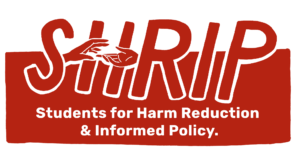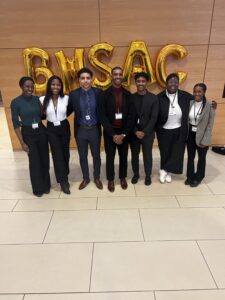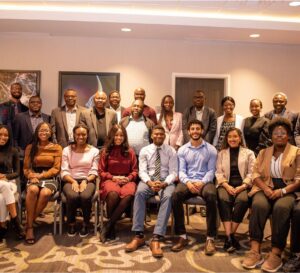
For the month of May 2022, medical students from the SHIRP student group were our guest bloggers. Students Ryan Krochak, Anthony Kanz, Baljit Pandher, Sarah Valentine, Adrian Teare, Lauren Ritchie, Erin White and Adam Wandzura share with us the importance of harm reduction in Saskatchewan and the specific health advocacy efforts of SHIRP. You can find more about SHIRP on Facebook (USask Students for Harm Reduction and Informed Policy), Instagram (@SHRIP_Sk), or by email (SHRIP.USask@gmail.com ).
Why is Harm Reduction Necessary in Saskatchewan?
The term harm reduction encompasses a range of health and social services that are rooted in respect and dignity. These services aim to minimize the negative consequences associated with substance use through non-judgemental and non-coercive methods. Harm reduction strategies offer an opportunity to keep people alive, provide support, and encourage positive change. Some examples of harm reduction include safe consumption sites, needle exchange programs, and drug testing strips.
In recent years, overdose fatalities have dramatically increased in Saskatchewan. The primary drugs driving the overdose crisis in Saskatchewan are opioids and methamphetamines.1,2 Notably, fentanyl has heavily permeated the drug supply within Canada. With Fentanyl being 30-50x more potent than heroin, even very small variabilities of fentanyl in a sample of drugs can have lethal effects.3 According to the most recent report released by the Saskatchewan Coroners Service, there were 446 suspected overdose deaths in 2021, representing a 39% increase from 2020 and a 390% increase from the 2010-2015 average.4 It should be noted that there have been zero overdose fatalities at safe consumption sites within the province.5
As this overdose crisis continues to grow, clinicians in all medical care disciplines are increasingly confronted with the infectious complications of substance use. Currently, Saskatchewan has the highest rate of HIV and second highest rate of Hepatitis C in Canada.6,7 The Saskatchewan Ministry of Health has identified that injection drug use (IDU) is the primary driving force behind the province’s HIV and Hep C epidemics.6,8 It is estimated that 67% of new HIV diagnoses and 52-61% of new Hep C infections in Saskatchewan are transmitted via IDU.
The Start of SHRIP
Harm reduction is a topic close to the hearts of many students in the College of Medicine. Yet, when the members of the class of 2024, who are passionate about this topic, began their search for student interest groups to join, there was nothing to be found. A small group of then-first-year students – Anthony Kanz, Baljit Pandher, Sarah Valentine, Adrian Teare, and Lauren Ritchie – gathered around a kitchen table and expressed their desire to do something to address the situation. From these humble beginnings, Students for Harm Reduction and Informed Policy (SHRIP) was born. They set out with a mission to advocate for patient-centered approaches toward substance use with a focus on providing education and creating conversation about harm reduction, drug policy, and community advocacy.
Since SHRIP’s inception, our group has made every effort to advocate for underserved populations, and provide awareness and education on the benefits of harm reduction. With a very grassroots approach, we sought to collaborate with community members and organizations whenever possible to develop a network of experts around us who we could learn from and support as they worked toward making meaningful change. We have learned so much from those who have been working tirelessly on the front lines serving people who use substances and feel honoured to be included in this community of support.
Our group’s origin story is very much one of not having a concrete plan, but instead having the unbridled passion of our group members (plus the extraordinary good fortune of being welcomed in by the experts in this community) led us to a variety of wonderful endeavours and learning experiences.
The main goals of SHRIP are to advocate for evidence-based harm reduction policies, to collaborate and support community-based organizations, and provide education on harm reduction principles.
The Current State of SHRIP
Today, the main goals of SHRIP remain unchanged, though the size of the group and the scope of our operations have greatly evolved. SHRIP has become the largest SMSS ratified student group and to best utilize our large team and maximize engagement, we are split into four separate task forces.
The Community Engagement task force is responsible for developing relationships with local organizations and community members. We aspire to learn about our community-based organizations and determine the best ways to support them – whether that is through volunteering, fundraising, or collecting donations of physical goods such as winter clothing, diapers, or food.
The Events task force is responsible for raising awareness of harm reduction principles amongst our colleagues both in the College of Medicine and in other professional health colleges at USask. For example, our events taskforce has planned harm reduction trivia nights, naloxone kit distribution and training, and educational talks such as trauma-informed care, substance use amongst physicians, and psychedelics in medicine.
The Policy task force is responsible for advocating for evidence-based harm reduction in Saskatchewan and beyond. We aspire to use our platform to raise community awareness, create dialogue, and make change. Prior to the 2022-23 Government of Saskatchewan budget release, SHRIP had the opportunity to be honoured guests of the official opposition and attend question period at the Saskatchewan legislature. We were very fortunate that the Minister of Health and the Minister of Mental Health and Addictions offered to meet and discuss why safe consumption sites are necessary in Saskatchewan. In response to the Government of Saskatchewan’s decision not to publicly fund safe consumption sites, SHRIP penned an open letter that highlighted the humanitarian and economic benefits of safe consumption sites. Our open letter received support from many professional health organizations such as the Canadian Medical Association, Saskatchewan Medical Association, Saskatchewan Union of Nurses, Saskatchewan Association of Social Workers, and many others.
The Social Media task force is responsible for educating the broader community on the importance of harm reduction, sharing the work of other local harm reduction advocates and community-based organizations, and highlighting the great work that people in our student group are doing. Notably, our social media team organizes and shares a weekly “Lit Blitz” in which one of our group members critically analyzes peer-reviewed literature and summarizes the information so that it is more accessible for the public. Topics have ranged from examining the link between housing and harm reduction to how nutrition and food security are essential components of harm reduction.
Harm reduction saves lives. Our group and the organizations/individuals we have been fortunate enough to work alongside know this to be true, and it remains our mission to spread this message as widely as possible. We are incredibly excited for another year of peer education on harm reduction, supporting community-based organizations, and advocating for evidence-based policy change. If you are interested in keeping up with our operations and initiatives, you can connect with us on Facebook (USask Students for Harm Reduction and Informed Policy), Instagram (@SHRIP_Sk), or by email (SHRIP.USask@gmail.com ).
References:
- Saskatchewan Coroners Service. Confirmed and Suspected Drug Toxicity Deaths (2010 – 2015) [Internet]. Government of Saskatchewan. [cited 2022 Mar 20]. Available from: https://publications.saskatchewan.ca/#/products/116473
- Martell C. Meth takes up 10x larger share of addiction treatment in Sask. than five years ago. CBC News [Internet]. 2019 May 8 [cited 2022 Mar 26]; Available from: https://www.cbc.ca/news/canada/saskatchewan/sask-meth-10x-increase-in-treatment-share-1.5127570
- Government of Canada. Fentanyl [Internet]. Government of Canada. Available from: https://www.canada.ca/en/health-canada/services/substance-use/controlled-illegal-drugs/fentanyl.html
- Di Donato N. “It’s right across the board’: Sask. reports record number of overdose deaths in 2021 [Internet]. CTV News. 2022 [cited 2022 Mar 26]. Available from: https://saskatoon.ctvnews.ca/it-s-right-across-the-board-sask-reports-record-number-of-overdose-deaths-in-2021-1.573800 0
- Simmonds E-M. PHR executive director responds after safe consumption services denied by provincial funding [Internet]. Global News. 2022 [cited 2022 Mar 26]. Available from: https://globalnews.ca/news/8708461/phr-executive-director-safe-consumption-services-provincial-funding/
- Saskatchewan.ca. HIV & AIDS in Saskatchewan (2019). Government of Saskatchewan;
- Public Health Agency of Canada. Hepatitis C in Canada: 2019 surveillance data [Internet]. Government of Canada. [cited 2022 Mar 26]. Available from: https://www.canada.ca/en/public-health/services/publications/diseases-conditions/hepatitis-c-2019-surveillance-data.html
- Hepatitis C in Saskatchewan (2017). Government of Saskatchewan; 2017. Available from: Saskatchewan.ca







